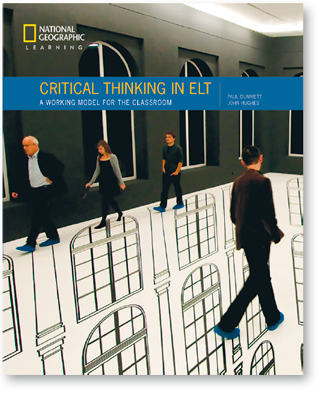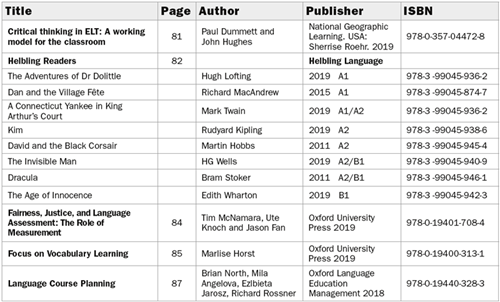Critical thinking in ELT: A working model for the classroom
Critical thinking in ELT: A working model for the classroom
Paul Dummett and John Hughes
National Geographic Learning 2019
See page 88 for details

Over the years there has been a vast array of books covering the topic of critical thinking (CT) in detail and, with various theoretical approaches, these books often specifically focused on CT for teaching in the tertiary sector. Since the global explosion of English learning and teaching and the development of the CEFR, the push to develop CT in ELT classes has increased. As a teacher of Academic Writing in a tertiary institution for many years, I have used a range of books or book chapters on critical thinking to develop lessons and supplementary materials for my classroom sessions on CT.
However, with all the books I have used that addressed CT, this comprehensive book by Dummett and Hughes is arguably the first book that so explicitly sets out to be an ELT resource with useful activities for language teachers to implement. In addition, it provides busy teachers with an approachable concise guide.
There are numerous definitions used by textbook writers for the term critical thinking, and Dummett and Hughes, as probably expected, do look at the possible definitions for the term. However, the point of difference is the fact that the authors for this book have surveyed teachers and it is the voices of the teachers that come through strongly, with quotes from teachers on defining CT. This style, inclusive of teachers’ voices, is woven into some of the chapters and this feature will possibly make teachers enjoy reading the book more as their voices are prominent in the chapters and they can relate to the supporting points. This is an impressive aspect of the book.
Overall, the book has seven chapters followed by a useful Appendices section that includes a glossary of terms, an Ask Yourself commentary, and potential answers to activities in the book. The authors conducted an online survey with a cohort of English language teachers to ascertain their views on critical thinking and the English language classroom. The final part of the Appendices section contains the full survey responses.
The first chapter in the book introduces the reader to a very valuable working model of critical thinking recommended by the authors. Initially the chapter addresses some key previous research studies on thinking, such as Bloom’s taxonomy and how the cognitive process connects to critical thinking. This is followed by the authors’ recommended model which presents a continuum from low-order thinking to higher-order thinking. On this continuum, the three key aspects, namely basic comprehension, critical thinking and creative thinking, are linked together and overlap. Each chapter includes some valuable advice from the authors and in Chapter 1 the advice is that ‘we must not fall into the trap of equating lower language proficiency with lower-order thinking’ (p12).
Chapter 2 provides a justification for the need to promote CT in language learners, how we can encourage autonomy in our learners, what the wider role of CT is in learning in contexts such as academia, business and everyday life, and the internet, and finally, the key benefits of developing critical thinking in General English language teaching.
After the initial two chapters, which address broader aspects of critical thinking, the following three chapters look at CT and how it can be developed in core course design areas. Chapter 3 covers the incorporation of CT driven activities in grammar, vocabulary and pronunciation classes. The part in Chapter 3 covering the link between pronunciation and CT was particularly interesting as the pragmatic messages around connotations underpinning conversations in English, including the emotional, social and cultural aspects, are covered. The following chapter (4) looks at receptive skills and the integration of CT, specifically addressing argumentation and evaluation. The activities focus on analysing authors and their perspectives, stance, tone of voice and aims and key skills. These are examined through analysing sources, facts and opinions, persuasive techniques, bias and assumptions, and implied meaning. Chapter 5 covers CT in productive skills. Productive skills, especially writing, can often pose a huge challenge to language learners and the activities in this chapter tackle some of those key challenging components, namely summary writing, peer evaluation, deconstructing text types and developing awareness of audience.
In Chapter 6, the focus shifts to 21st century skills and literacies and the need for critical thinking skills to manage the changes successfully. The final chapter (7) addresses the integration of CT into existing lessons, which is a realistic approach to adopt as most teachers are working within existing courses and lessons, and they do not want to reinvent the wheel as it were.
From the beginning to the end, the target audience for the book is clearly teachers of English and their learners, and each chapter has a number of really valuable activities that teachers can use to develop critical thinking in their students across all the skills. These activities are recommended for specific CEFR levels and they are good models which enable teachers to use them to design similar activities for the level of their students. A particularly useful component of each chapter is the insert titled ‘Ask yourself’ that encourages teachers to reflect on their own practices and critically evaluate the resources they use.
When I did an initial scan of the structure of the book I thought it looked a bit sparse and light in content, but as soon as I started to read the book I realised that in terms of content, it was packed with useful resources and ideas that could be easily implemented into ELT courses. Also, the structure makes the details easily accessible for most teachers without too much additional information to detract from core aspects, as can sometimes occur in teacher resources.
I strongly recommend this as a resource for teachers across all levels who are trying to develop CT in their language learners. It can also be used as an additional supplementary resource for teachers in an existing programme. I think the usefulness of this resource extends to all aspects of English teaching, including EAP.
Dr Anthea Fester
Anthea Fester is a Senior Academic Staff Member, Waikato Institute of Technology (Wintec), Hamilton, New Zealand
Summary of books reviewed

Future issues
If you have any articles on the themes below, I would like to hear from you. Articles should be 1200–1800 words.
For any further information contact me at Robert.mclarty@pavpub.com
Topics for 2020
Summary of books reviewed

Future issues
If you have any articles on the themes below, I would like to hear from you. Articles should be 1200–1800 words.
For any further information contact me at Robert.mclarty@pavpub.com

Comments
Write a Comment
Comment Submitted